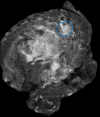Prevalence of Imaging-Detected Silent Female Breast Cancer in Autopsy Specimens: A Study Using Image-Guided Biopsies
- PMID: 36686129
- PMCID: PMC9854332
- DOI: 10.7759/cureus.32776
Prevalence of Imaging-Detected Silent Female Breast Cancer in Autopsy Specimens: A Study Using Image-Guided Biopsies
Abstract
Background This study was conducted to evaluate the prevalence of imaging-detected silent breast cancer in females, with the hypothesis that the incidence of imaging-detected silent breast cancer in females is greater than the true disease incidence. The main purpose of this study is the attempt to prove whether breast imaging can identify silent breast cancers that apparently are common in serial histology analysis. Methodology A series of 217 consecutive medicolegal autopsies on fresh Portuguese cadavers were performed from July 2016 to December 2019 at the National Institute of Legal Medicine and Forensic Science, Lisbon, Portugal. The criteria for exclusion were age younger than 40 years, the autopsy performed in less than 48 hours after death, any major injury to one or both breasts, and known or clinically evident breast cancer. Once the eligibility criteria were met, and the sample collection authorization was obtained, a bilateral subcutaneous modi-fied radical mastectomy was performed in each fresh cadaver at the National Institute of Legal Medicine and Forensic Science. Mammography, ecography, and excisional biopsies of suspect areas were conducted on the collected samples. Results The indication for excisional biopsy by imaging was assigned in eight cases, and no breast cancer was discovered in the excised specimens. Conclusions In light of the findings, it cannot be concluded that the imaging-detected silent breast cancer prevalence is higher than the actual incidence of the disease, so the author's initial hypothesis was rejected. Mammography does not overdiagnose breast cancer. Benign breast alterations are common, accounting for 43.6% of the corpses collected, while low-suspicion alterations were discovered in 1.84% of breast samples. The objective examination, which included inspection and palpation, missed 37.5% of the biopsied breast changes. This finding indicated that an objective examination leads to a significant number of false-negative results which cannot be used as a screening method.
Keywords: breast cancer screening; forensic autopsy; mammography; overdiagnosis; silent breast cancer.
Copyright © 2022, Sidiropoulou et al.
Conflict of interest statement
The authors have declared that no competing interests exist.
Figures






References
-
- Cancer incidence and mortality worldwide: sources, methods and major patterns in GLOBOCAN 2012. Ferlay J, Soerjomataram I, Dikshit R, et al. Int J Cancer. 2015;136:0–86. - PubMed
-
- Cancer incidence and mortality patterns in Europe: estimates for 40 countries in 2012. Ferlay J, Steliarova-Foucher E, Lortet-Tieulent J, et al. Eur J Cancer. 2013;49:1374–1403. - PubMed
-
- Eurostat. Cancer statistics. [ May; 2022 ]. 2022. http://ec.europa.eu/eurostat/statistics-explained/index.php/Cancer_stati... http://ec.europa.eu/eurostat/statistics-explained/index.php/Cancer_stati...
-
- Prevalence of benign, atypical, and malignant breast lesions in populations at different risk for breast cancer. A forensic autopsy study. Bartow SA, Pathak DR, Black WC, Key CR, Teaf SR. Cancer. 1987;60:2751–2760. - PubMed
LinkOut - more resources
Full Text Sources
Miscellaneous
